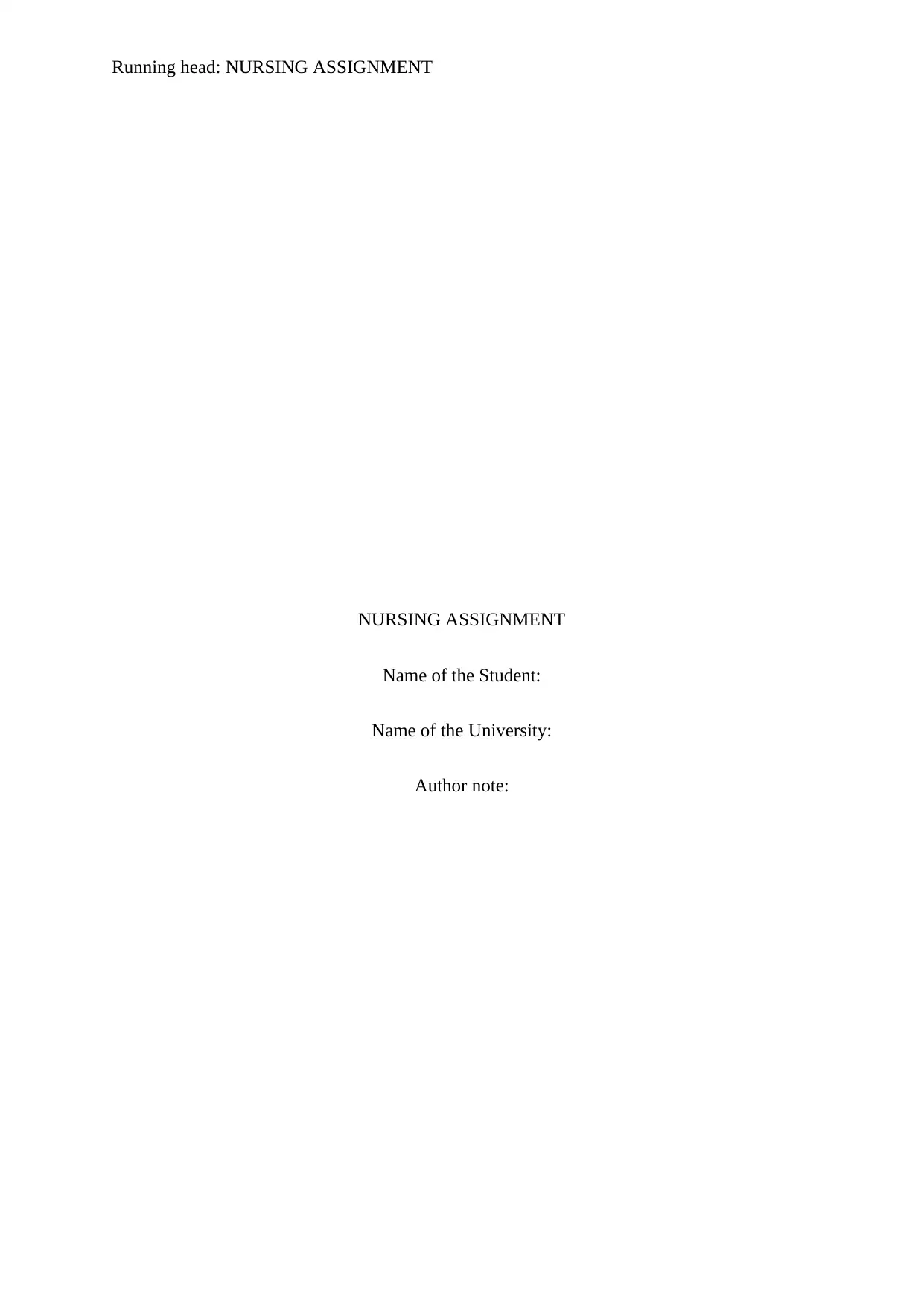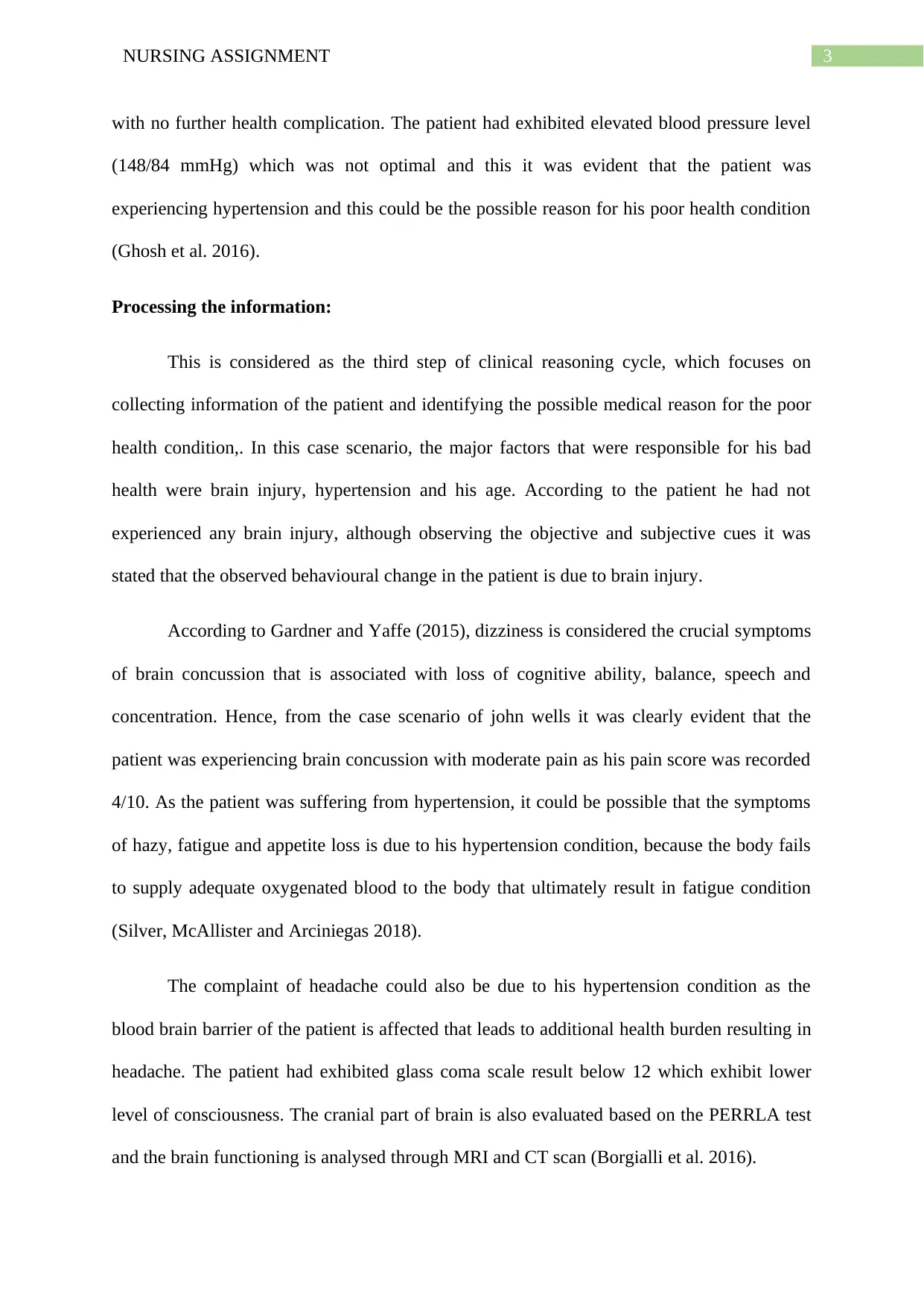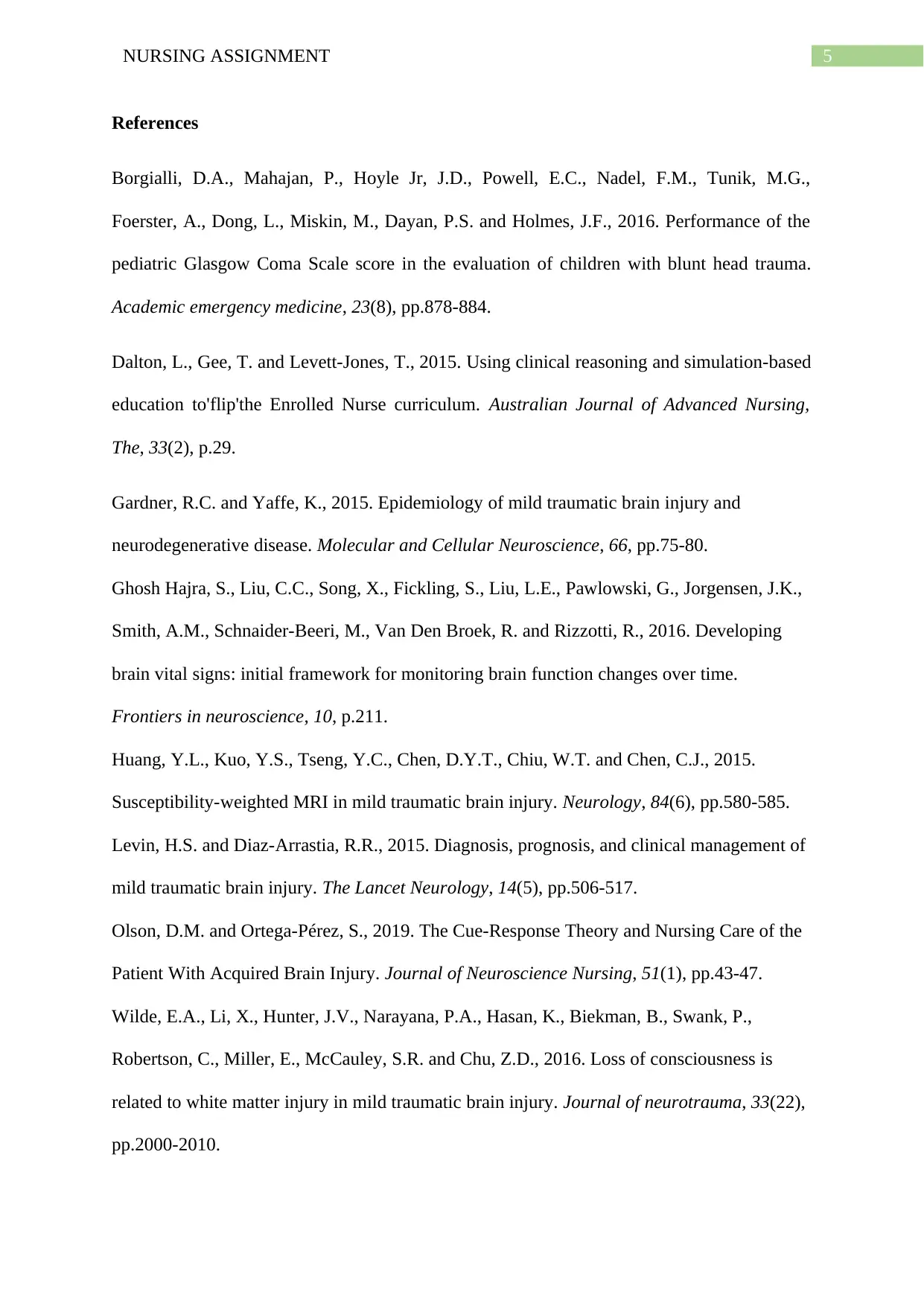Nursing Case Study: Clinical Reasoning Analysis of John Wells's Case
VerifiedAdded on 2022/10/11
|7
|1615
|14
Case Study
AI Summary
This nursing assignment presents a clinical reasoning report based on the case of John Wells, an 82-year-old farmer admitted to the emergency department following a fall and head injury. The report meticulously details the clinical reasoning cycle, commencing with considering the patient's situation, which includes his age, history of mild hypertension, and the circumstances of the accident. The assignment progresses to the collection of subjective and objective cues, including assessments such as the Glasgow Coma Scale (GCS) and PERRLA, alongside vital signs evaluation. The processing of information involves identifying potential causes for the patient's symptoms, such as confusion, fatigue, and headache, linking them to both the head injury and hypertension. The report references relevant literature to support the analysis, emphasizing the importance of recognizing and addressing both neurological and cardiovascular factors in patient care.

Running head: NURSING ASSIGNMENT
NURSING ASSIGNMENT
Name of the Student:
Name of the University:
Author note:
NURSING ASSIGNMENT
Name of the Student:
Name of the University:
Author note:
Paraphrase This Document
Need a fresh take? Get an instant paraphrase of this document with our AI Paraphraser

1NURSING ASSIGNMENT
Considering the patient situation:
This is considered as the first step of clinical reasoning cycle, which focuses on
considering and highlighting the patient’s situation. This study will focus on the case scenario
of the patient named, John Wells, 82-years-old man, who was admitted to emergency
department for his behavioural changes. John was a farmer and had exhibited no past medical
condition of concussion or head injury. He was initially diagnosed with the condition of mild
hypertension and had also reported to not consume any antihypertensive medicines. After
completely evaluating the patient, it was exhibited that he lost his balance while returning
from his work and had injured his left part of the head by hitting the ground. After the
accident, his wife had observed some behavioural changes in him and had therefore
approached her son to take John to the hospital. He had abrasion on his left forearm and tear
on his left elbow and apart from the above physical injury no other major injury was detected.
After evaluating the patient, the primary health complaint exhibited by John was
confusion, fatigue, appetite loss, nausea and headache. After falling from his stationary two-
wheeler bike, he had hit his left part of the head really hard on the summer ground and hence
it was highly possible that his cognitive function would have been disturbed and he might
exhibit the complaint of internal brain injury (Zacks et al. 2016). The other major reason for
his loss of balance could be hypertension as he was taking any antihypertensive medicines.
Hence, the two major risk factors that could be responsible for the condition of headache and
fatigue followed by nausea are hypertension and head injury (Levin and Diaz 2015).
Collecting cues and information:
This is considered as the second step of clinical reasoning cycle, which focuses on
gathering relevant information and medical history of the patient in order to demonstrate and
execute an effective care plan for the patient (Dalton, Gee and Levett-Jones 2015). The
Considering the patient situation:
This is considered as the first step of clinical reasoning cycle, which focuses on
considering and highlighting the patient’s situation. This study will focus on the case scenario
of the patient named, John Wells, 82-years-old man, who was admitted to emergency
department for his behavioural changes. John was a farmer and had exhibited no past medical
condition of concussion or head injury. He was initially diagnosed with the condition of mild
hypertension and had also reported to not consume any antihypertensive medicines. After
completely evaluating the patient, it was exhibited that he lost his balance while returning
from his work and had injured his left part of the head by hitting the ground. After the
accident, his wife had observed some behavioural changes in him and had therefore
approached her son to take John to the hospital. He had abrasion on his left forearm and tear
on his left elbow and apart from the above physical injury no other major injury was detected.
After evaluating the patient, the primary health complaint exhibited by John was
confusion, fatigue, appetite loss, nausea and headache. After falling from his stationary two-
wheeler bike, he had hit his left part of the head really hard on the summer ground and hence
it was highly possible that his cognitive function would have been disturbed and he might
exhibit the complaint of internal brain injury (Zacks et al. 2016). The other major reason for
his loss of balance could be hypertension as he was taking any antihypertensive medicines.
Hence, the two major risk factors that could be responsible for the condition of headache and
fatigue followed by nausea are hypertension and head injury (Levin and Diaz 2015).
Collecting cues and information:
This is considered as the second step of clinical reasoning cycle, which focuses on
gathering relevant information and medical history of the patient in order to demonstrate and
execute an effective care plan for the patient (Dalton, Gee and Levett-Jones 2015). The

2NURSING ASSIGNMENT
subjective and objective cues are collected in this phase and thus based on the above
mentioned cues a care plan is devised for a better health outcome of the patient.
In this case scenario, the subjective cues of the patient is gathered after interviewing
him which consist of headache, dizziness confusion, poor consciousness, nausea and loss of
appetite. In order to evaluate the consciousness level of the patient, Glass coma scale test is
performed, particularly for the individual who are suffering from any form of brain injury
(Olson and Ortega 2019).
The consciousness level is evaluated through the verbal response, eye response and
motor response and based on the response, an individual score is provided. The score can
vary from the range of 3-15, and hence if the score is less than 8, it will exhibit that the
patient had low level of consciousness and might also experience from severe brain injury
(Wilde et al. 2016). If the score result is in between 9 to 12, it is exhibited that the patient has
moderate consciousness level and might experience from moderate brain injury, whereas
score result between 13-15 exhibit normal health conditions with no chance of brain injury.
To guarantee if the patient had not experienced any internal brain injury, PERRLA
test is performed by evaluating the pupil dilatation of the patient, the level of internal cranial
injury is assessed. Along with the above mentioned test MRI and CT scan can also be
performed to evaluate the subjective cues of the patient and diagnose the health condition of
the patient (Huang et al. 2015).
In this case scenario, the objective cues of the patient is collected by performing a
vital assessment test which consist of pulse rate, oxygen saturation rate, blood pressure, body
temperature and respiratory rate. After evaluating the vital signs it was observed that the
patient had exhibited optimal body temperature (37.6 degree Celsius), pulse rate (82 beats per
minute), oxygen saturation (greater than 95%) and respiratory rate (17 breaths per minute)
subjective and objective cues are collected in this phase and thus based on the above
mentioned cues a care plan is devised for a better health outcome of the patient.
In this case scenario, the subjective cues of the patient is gathered after interviewing
him which consist of headache, dizziness confusion, poor consciousness, nausea and loss of
appetite. In order to evaluate the consciousness level of the patient, Glass coma scale test is
performed, particularly for the individual who are suffering from any form of brain injury
(Olson and Ortega 2019).
The consciousness level is evaluated through the verbal response, eye response and
motor response and based on the response, an individual score is provided. The score can
vary from the range of 3-15, and hence if the score is less than 8, it will exhibit that the
patient had low level of consciousness and might also experience from severe brain injury
(Wilde et al. 2016). If the score result is in between 9 to 12, it is exhibited that the patient has
moderate consciousness level and might experience from moderate brain injury, whereas
score result between 13-15 exhibit normal health conditions with no chance of brain injury.
To guarantee if the patient had not experienced any internal brain injury, PERRLA
test is performed by evaluating the pupil dilatation of the patient, the level of internal cranial
injury is assessed. Along with the above mentioned test MRI and CT scan can also be
performed to evaluate the subjective cues of the patient and diagnose the health condition of
the patient (Huang et al. 2015).
In this case scenario, the objective cues of the patient is collected by performing a
vital assessment test which consist of pulse rate, oxygen saturation rate, blood pressure, body
temperature and respiratory rate. After evaluating the vital signs it was observed that the
patient had exhibited optimal body temperature (37.6 degree Celsius), pulse rate (82 beats per
minute), oxygen saturation (greater than 95%) and respiratory rate (17 breaths per minute)
⊘ This is a preview!⊘
Do you want full access?
Subscribe today to unlock all pages.

Trusted by 1+ million students worldwide

3NURSING ASSIGNMENT
with no further health complication. The patient had exhibited elevated blood pressure level
(148/84 mmHg) which was not optimal and this it was evident that the patient was
experiencing hypertension and this could be the possible reason for his poor health condition
(Ghosh et al. 2016).
Processing the information:
This is considered as the third step of clinical reasoning cycle, which focuses on
collecting information of the patient and identifying the possible medical reason for the poor
health condition,. In this case scenario, the major factors that were responsible for his bad
health were brain injury, hypertension and his age. According to the patient he had not
experienced any brain injury, although observing the objective and subjective cues it was
stated that the observed behavioural change in the patient is due to brain injury.
According to Gardner and Yaffe (2015), dizziness is considered the crucial symptoms
of brain concussion that is associated with loss of cognitive ability, balance, speech and
concentration. Hence, from the case scenario of john wells it was clearly evident that the
patient was experiencing brain concussion with moderate pain as his pain score was recorded
4/10. As the patient was suffering from hypertension, it could be possible that the symptoms
of hazy, fatigue and appetite loss is due to his hypertension condition, because the body fails
to supply adequate oxygenated blood to the body that ultimately result in fatigue condition
(Silver, McAllister and Arciniegas 2018).
The complaint of headache could also be due to his hypertension condition as the
blood brain barrier of the patient is affected that leads to additional health burden resulting in
headache. The patient had exhibited glass coma scale result below 12 which exhibit lower
level of consciousness. The cranial part of brain is also evaluated based on the PERRLA test
and the brain functioning is analysed through MRI and CT scan (Borgialli et al. 2016).
with no further health complication. The patient had exhibited elevated blood pressure level
(148/84 mmHg) which was not optimal and this it was evident that the patient was
experiencing hypertension and this could be the possible reason for his poor health condition
(Ghosh et al. 2016).
Processing the information:
This is considered as the third step of clinical reasoning cycle, which focuses on
collecting information of the patient and identifying the possible medical reason for the poor
health condition,. In this case scenario, the major factors that were responsible for his bad
health were brain injury, hypertension and his age. According to the patient he had not
experienced any brain injury, although observing the objective and subjective cues it was
stated that the observed behavioural change in the patient is due to brain injury.
According to Gardner and Yaffe (2015), dizziness is considered the crucial symptoms
of brain concussion that is associated with loss of cognitive ability, balance, speech and
concentration. Hence, from the case scenario of john wells it was clearly evident that the
patient was experiencing brain concussion with moderate pain as his pain score was recorded
4/10. As the patient was suffering from hypertension, it could be possible that the symptoms
of hazy, fatigue and appetite loss is due to his hypertension condition, because the body fails
to supply adequate oxygenated blood to the body that ultimately result in fatigue condition
(Silver, McAllister and Arciniegas 2018).
The complaint of headache could also be due to his hypertension condition as the
blood brain barrier of the patient is affected that leads to additional health burden resulting in
headache. The patient had exhibited glass coma scale result below 12 which exhibit lower
level of consciousness. The cranial part of brain is also evaluated based on the PERRLA test
and the brain functioning is analysed through MRI and CT scan (Borgialli et al. 2016).
Paraphrase This Document
Need a fresh take? Get an instant paraphrase of this document with our AI Paraphraser

4NURSING ASSIGNMENT
Hence, from the above evaluation it is evident that the existing physical and mental
health of the patient is observed followed by his cognitive functioning and is further assessed
to highlight the presence of any brain injury in the patient.
Hence, from the above evaluation it is evident that the existing physical and mental
health of the patient is observed followed by his cognitive functioning and is further assessed
to highlight the presence of any brain injury in the patient.

5NURSING ASSIGNMENT
References
Borgialli, D.A., Mahajan, P., Hoyle Jr, J.D., Powell, E.C., Nadel, F.M., Tunik, M.G.,
Foerster, A., Dong, L., Miskin, M., Dayan, P.S. and Holmes, J.F., 2016. Performance of the
pediatric Glasgow Coma Scale score in the evaluation of children with blunt head trauma.
Academic emergency medicine, 23(8), pp.878-884.
Dalton, L., Gee, T. and Levett-Jones, T., 2015. Using clinical reasoning and simulation-based
education to'flip'the Enrolled Nurse curriculum. Australian Journal of Advanced Nursing,
The, 33(2), p.29.
Gardner, R.C. and Yaffe, K., 2015. Epidemiology of mild traumatic brain injury and
neurodegenerative disease. Molecular and Cellular Neuroscience, 66, pp.75-80.
Ghosh Hajra, S., Liu, C.C., Song, X., Fickling, S., Liu, L.E., Pawlowski, G., Jorgensen, J.K.,
Smith, A.M., Schnaider-Beeri, M., Van Den Broek, R. and Rizzotti, R., 2016. Developing
brain vital signs: initial framework for monitoring brain function changes over time.
Frontiers in neuroscience, 10, p.211.
Huang, Y.L., Kuo, Y.S., Tseng, Y.C., Chen, D.Y.T., Chiu, W.T. and Chen, C.J., 2015.
Susceptibility-weighted MRI in mild traumatic brain injury. Neurology, 84(6), pp.580-585.
Levin, H.S. and Diaz-Arrastia, R.R., 2015. Diagnosis, prognosis, and clinical management of
mild traumatic brain injury. The Lancet Neurology, 14(5), pp.506-517.
Olson, D.M. and Ortega-Pérez, S., 2019. The Cue-Response Theory and Nursing Care of the
Patient With Acquired Brain Injury. Journal of Neuroscience Nursing, 51(1), pp.43-47.
Wilde, E.A., Li, X., Hunter, J.V., Narayana, P.A., Hasan, K., Biekman, B., Swank, P.,
Robertson, C., Miller, E., McCauley, S.R. and Chu, Z.D., 2016. Loss of consciousness is
related to white matter injury in mild traumatic brain injury. Journal of neurotrauma, 33(22),
pp.2000-2010.
References
Borgialli, D.A., Mahajan, P., Hoyle Jr, J.D., Powell, E.C., Nadel, F.M., Tunik, M.G.,
Foerster, A., Dong, L., Miskin, M., Dayan, P.S. and Holmes, J.F., 2016. Performance of the
pediatric Glasgow Coma Scale score in the evaluation of children with blunt head trauma.
Academic emergency medicine, 23(8), pp.878-884.
Dalton, L., Gee, T. and Levett-Jones, T., 2015. Using clinical reasoning and simulation-based
education to'flip'the Enrolled Nurse curriculum. Australian Journal of Advanced Nursing,
The, 33(2), p.29.
Gardner, R.C. and Yaffe, K., 2015. Epidemiology of mild traumatic brain injury and
neurodegenerative disease. Molecular and Cellular Neuroscience, 66, pp.75-80.
Ghosh Hajra, S., Liu, C.C., Song, X., Fickling, S., Liu, L.E., Pawlowski, G., Jorgensen, J.K.,
Smith, A.M., Schnaider-Beeri, M., Van Den Broek, R. and Rizzotti, R., 2016. Developing
brain vital signs: initial framework for monitoring brain function changes over time.
Frontiers in neuroscience, 10, p.211.
Huang, Y.L., Kuo, Y.S., Tseng, Y.C., Chen, D.Y.T., Chiu, W.T. and Chen, C.J., 2015.
Susceptibility-weighted MRI in mild traumatic brain injury. Neurology, 84(6), pp.580-585.
Levin, H.S. and Diaz-Arrastia, R.R., 2015. Diagnosis, prognosis, and clinical management of
mild traumatic brain injury. The Lancet Neurology, 14(5), pp.506-517.
Olson, D.M. and Ortega-Pérez, S., 2019. The Cue-Response Theory and Nursing Care of the
Patient With Acquired Brain Injury. Journal of Neuroscience Nursing, 51(1), pp.43-47.
Wilde, E.A., Li, X., Hunter, J.V., Narayana, P.A., Hasan, K., Biekman, B., Swank, P.,
Robertson, C., Miller, E., McCauley, S.R. and Chu, Z.D., 2016. Loss of consciousness is
related to white matter injury in mild traumatic brain injury. Journal of neurotrauma, 33(22),
pp.2000-2010.
⊘ This is a preview!⊘
Do you want full access?
Subscribe today to unlock all pages.

Trusted by 1+ million students worldwide

6NURSING ASSIGNMENT
Zacks, J.M., Kurby, C.A., Landazabal, C.S., Krueger, F. and Grafman, J., 2016. Effects of
penetrating traumatic brain injury on event segmentation and memory. Cortex, 74, pp.233-
246.
Zacks, J.M., Kurby, C.A., Landazabal, C.S., Krueger, F. and Grafman, J., 2016. Effects of
penetrating traumatic brain injury on event segmentation and memory. Cortex, 74, pp.233-
246.
1 out of 7
Related Documents
Your All-in-One AI-Powered Toolkit for Academic Success.
+13062052269
info@desklib.com
Available 24*7 on WhatsApp / Email
![[object Object]](/_next/static/media/star-bottom.7253800d.svg)
Unlock your academic potential
Copyright © 2020–2025 A2Z Services. All Rights Reserved. Developed and managed by ZUCOL.





